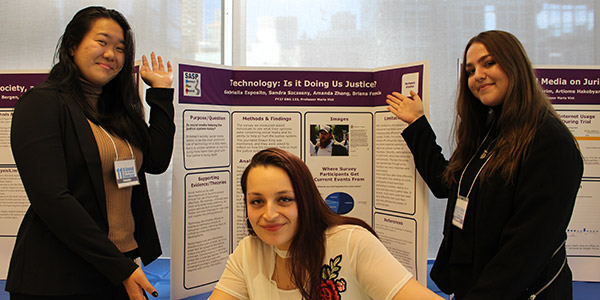
On December 6, John Jay held its 11th annual First-Year Student Showcase, highlighting the research and creativity of the freshman class. The showcase gave students—many of whom have never conducted research or presented in front of a large group—the opportunity to shine. More than 375 presentations covered a broad array of topics, from immigration and the opioid epidemic, to police brutality and medical insurance. After thanking the 73 faculty members, staff professionals, and student coaches that helped guide the first-year students through their research, President Karol V. Mason got the crowd going by calling out each of the groups heavily represented at the event—APPLE Corps, ACE, Adelante, Early Start, and SEEK. “I’m excited to walk around and see all of your research,” said Mason. “And please walk around and learn from each other. That’s what we’re here for.” To find out more about the First-Year Student Showcase experience, we had the opportunity to interview two incredible students before and during the event.

Yi-Chen Wu
“When we were presenting, our classmates were by our sides, so it was not as intimidating as we thought it would be.” —Yi-Chen Wu
Yi-Chen “Tina” Wu
Wu is an international student from Taiwan, majoring in Forensic Psychology and is in the Early Start Program. For her First-Year Student Showcase project, Wu and her team researched black police brutality victims with missing internal organs. Before the showcase the team reviewed lawsuit documents, autopsy reports, news broadcasts, and even popular films, like Get Out, to help understand the topic. “There was a case that we reviewed in class about Everett Palmer Jr. He was a 41-year-old veteran who died in custody,” said Wu. “The law enforcement agencies immediately concluded his death as a suicide. But what makes it suspicious is that his brain, heart, throat, and spine were missing. We looked into how surviving relatives can file federal civil rights lawsuits.”
Wu went on to explain that coming from Taiwan she wasn’t familiar with racism in America, but to give her research context, she researched discrimination against black Americans both currently and historically, specifically Dr. James Marion Sims’ medical experimentation on enslaved black women without anesthesia. “They justified their practices by saying that blacks are insensitive to pain and that they are subhuman,” said Wu. “In Get Out, they took away black people’s organs because they believed that blacks were physically supernatural.” Wu hopes that her presentation helps others become more aware of their rights when a deceased victim’s internal organs go missing, and she hopes to go back to Taiwan and help formerly incarcerated people transition back into society.
As for the experience presenting at the First-Year Student Showcase, Wu was happy to have teammates. “During the presentation, my group members helped each other out by picking up where you left off,” said Wu. “Luckily, when we were presenting, our classmates were by our sides, so it was not as intimidating as we thought it would be.”

Maral Artykova
“I learned to be patient and listen to my groupmates, which led to us having a great project and research.” — Maral Artykova
Maral Artykova
Artykova is an immigrant from Turkmenistan who moved to the United States when she was 15 years old. As members of the APPLE Corps program, Artykova and her team researched how litter affects the perception of criminality in a neighborhood for their First-Year Student Showcase project. Prior to the event, the team went to five different New York City neighborhoods, asking people questions about their quality of life and how it changed throughout the years. “We asked, ‘Have you seen littering in this neighborhood? What do you think about the litter in this neighborhood? Is it a big or small problem?’” said Artykova. “At the end, our whole analysis came to the conclusion that people who saw someone litter that day had a bigger perception of criminality in that neighborhood.”
Understanding the conclusions of her research, Artykova urged everyone not to create stereotypes about those that live in litter-filled neighborhoods. “We talked to the people in the neighborhoods that had a bunch of litter, and they were very nice and interested in this topic,” said Artykova. “It’s very wrong for us to assume that because there is litter in a neighborhood that it’s a dangerous place and no one should go there.” Artykova hopes that her presentation helps others become more aware of the labels people create based on initial perceptions.
“I am interested in breaking down stereotypes because I am an immigrant and I advocate for those who are wrongly accused of being bad people,” she said. “One of my solutions for this project was to look into the Department of Sanitation’s budget and see how we can allocate some money into cleaning up these neighborhoods and changing the stereotypes.” Using this presentation as a stepping stone, Artykova is looking forward to one day working in the Community Affairs Bureau of the NYPD where she can use her public speaking and people skills to improve communities.
Artykova was grateful for what she learned from the First-Year Student Showcase experience. “The showcase taught me patience. I was rushing because I wanted to get everything done quickly and my groupmates told me I had to be patient. They didn’t want to rush or jump to conclusions,” said Artykova. “I learned to be patient and listen to my groupmates, which led us to having a great project and research.”
More scenes from the event:













